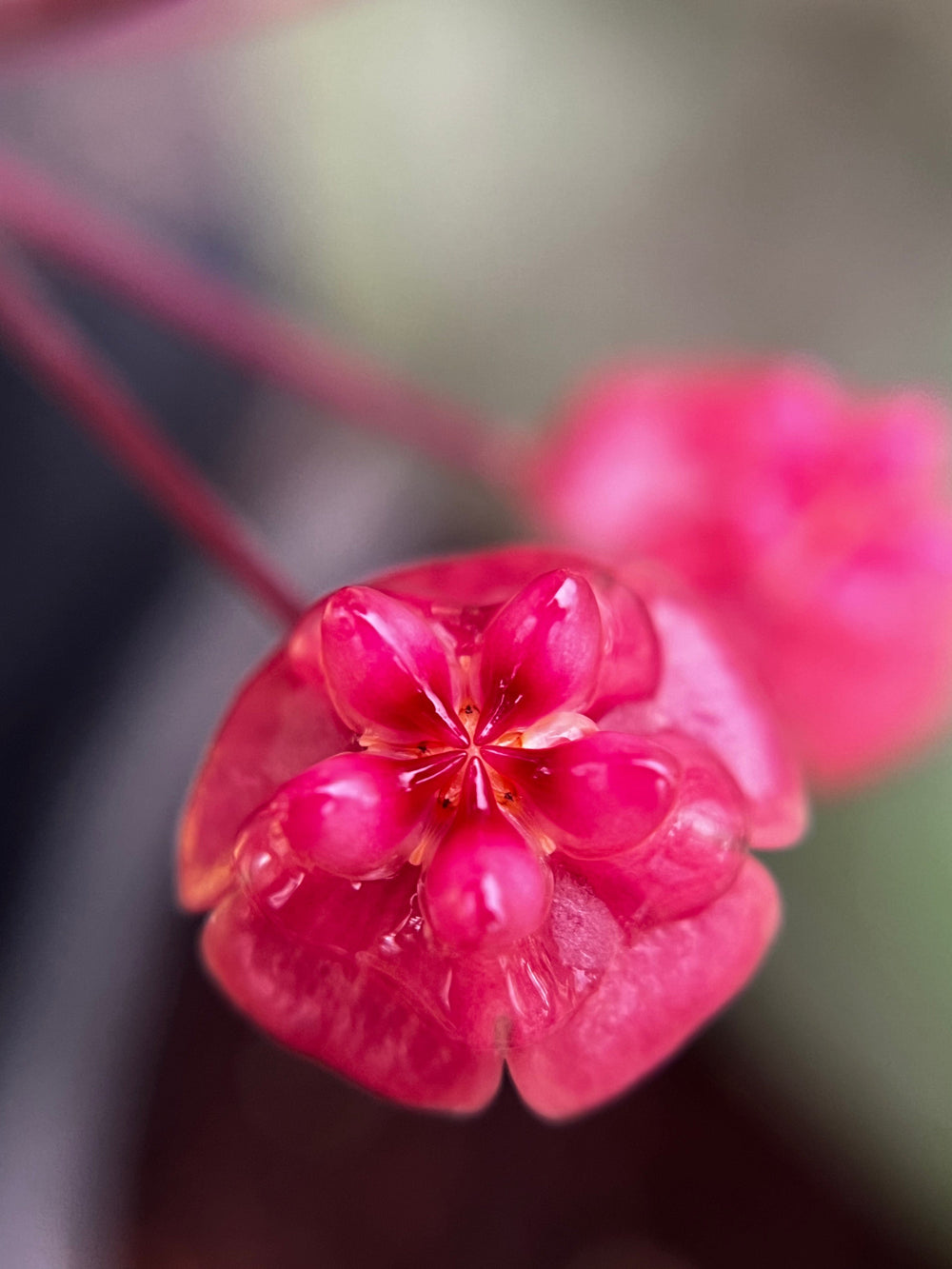How to Fertilize Houseplants: Help Your Plants Thrive

Table of Contents
- Why Fertilize Indoor Plants?
- When to Feed Houseplants
- Choosing the Right Fertilizer for Indoor Plants
- Types of Houseplant Fertilizer
- How to Fertilize Your Houseplants: 3 Popular Methods
- What About Plant Care for Hoyas?
- Conclusion
Many people are hesitant to invest in houseplants because they are unsure of how to properly care for them. One of the key components of taking care of your houseplants is fertilization. After all, plants don't live on water alone!
Fertilizing plants can be a bit overwhelming for beginners. Different plants have different chemical needs, and so fertilizing components, methods, and timelines can vary from plant to plant
In this blog post, I will give you some general tips on how to fertilize indoor plants, why it is important, and hopefully convince you to add a beginner-friendly Hoya to your collection.
Why Fertilize Indoor Plants?

When plants are grown in containers, they are limited in the amount of nutrients available to them compared to outdoor plants. Over time, the nutrients in the soil can become depleted, leading to stunted growth and yellowing leaves.
If you're using another substrate instead of potting soil (such as coco husk, coco coir, perlite, and more), these mediums do not have the nutrient qualities of soil, so it becomes even more important to provide your plants with adequate nutrition.
Using a houseplant fertilizer provides a plant's necessary chemical diet, using components such as nitrogen, phosphorus, and potassium, to promote healthy growth and prevent deficiencies. That's why fertilizing is crucial to the health and growth of houseplants.
When to Feed Houseplants

The short answer is that frequency and timing of fertilization depend on the specific plant species, soil type, and season. You'll need to know these factors before starting a schedule that works for your plant.
Generally, houseplants need fertilization every 2-4 weeks during their active growth phase, which is typically spring and summer. During the fall and winter, when plants are in a dormant phase, they require less frequent fertilization, usually every 6-8 weeks.
Even with these guidelines, it is important to monitor the plant’s growth and adjust fertilization accordingly. Over-fertilization can be just as harmful as under-fertilization, so it’s important not to overdo it.
Choosing the Right Fertilizer for Indoor Plants

There are many different types of fertilizers available, and it can be overwhelming to choose the right one for your houseplant. It’s important to choose a fertilizer that is specifically formulated for indoor plants.
Types of Houseplant Fertilizer

Not all fertilizers are created equal! Make sure you're getting one that helps your plants, instead of harming them.
Outdoor Fertilizers

Outdoor fertilizers may contain high levels of nitrogen, which can burn the roots of indoor plants. Don't get one of these by accident and hurt your plants! If it's not for indoor plants, it will likely be too strong.
Organic Fertilizers

Organic fertilizers are made from natural materials, such as compost, coffee grounds, or bone meal, and are generally slower to release nutrients. They are gentler on plants and the environment, but natural fertilizers may not provide the immediate boost that synthetic fertilizers do.
Synthetic Fertilizers

Synthetic fertilizers are made from chemical compounds and are generally quicker to release nutrients. They provide an immediate boost to plants but can be harsh on an outdoor environment and may cause salt buildup in the soil over time. Use these with care on outdoor potted plants, where runoff from watering would be common.
How to Fertilize Your Houseplants: 3 Popular Methods

There's more than one way to feed your houseplants, and some methods will be more beneficial than others. We'll break down the pros and cons for you here:
Foliar Fertilization

Foliar fertilization refers to the application of liquid fertilizer directly onto the leaves of plants. Here are some pros and cons of foliar fertilization:
Pros:
- Increased nutrient uptake: Foliar fertilization can provide a quick and efficient way of delivering nutrients directly to the plant. The nutrients are absorbed through the leaves and can be quickly transported to the areas of the plant that need them most.
- Improved plant growth and health: Foliar fertilization can help improve plant growth, vigor, and overall health. It can also help plants recover from stress and damage caused by pests, disease, or adverse weather conditions.
- Reduced soil nutrient deficiencies: Foliar fertilization can help reduce soil nutrient deficiencies, especially in plants that have shallow root systems or are growing in nutrient-poor soils.
- Precision application: Foliar fertilization allows for precise application of nutrients, which can help minimize waste and reduce the risk of over-fertilization.
Cons:
- Limited nutrient uptake: While foliar fertilization can be an effective way of delivering nutrients to plants, it is limited by the ability of the plant to absorb the nutrients. Some nutrients may not be easily absorbed through the leaves, or may require specific conditions for uptake.
- Limited nutrient mobility: The nutrients applied through foliar fertilization are limited in their mobility within the plant. This means that they may not be distributed evenly throughout the plant, and may not reach areas of the plant that need them most.
- Risk of damage: Foliar fertilization can be risky if not done correctly. Over-fertilization can damage the leaves and cause leaf burn, while under-fertilization may not provide sufficient nutrients to the plant.
- Temporary effect: Foliar fertilization can provide a quick boost to plant growth and health, but the effect is usually temporary. For long-term improvements in plant growth and health, it is important to address underlying soil nutrient deficiencies.
Fertigation

Fertigation is the process of applying liquid fertilizer to plants in their water. Here are some pros and cons of fertigation:
Pros:
-
Increased nutrient uptake: Fertigation provides a direct and efficient way to deliver nutrients to the plant roots. Water-soluble fertilizers can be quickly absorbed by the roots.
-
Improved plant growth and health: Fertigation can help improve plant growth, yield, and overall health. It can also help plants recover from stress and damage caused by pests, disease, or adverse weather conditions.
-
Reduced water use: Fertigation allows for precise application of nutrients, which can help minimize waste and reduce the amount of water needed.
Cons:
-
Risk of over-fertilization: Fertigation requires careful management to prevent over-fertilization, which can lead to nutrient imbalances, toxicity, and environmental pollution.
-
Dependency on watering: Fertigation is dependent on watering your plants, which means that it may not be suitable for plants that do not require regular watering.
Overall, fertigation can be a highly effective method of fertilizer application, but it requires careful management and monitoring to avoid over-fertilization and other potential issues.
Slow Release Top-dressing

Slow-release fertilizers are granular fertilizers designed to release nutrients over an extended period, providing a consistent and gradual supply of macro and micronutrients to plants. Here are some pros and cons of using slow-release fertilizers:
Pros:
- Improved plant growth: Slow-release fertilizers provide a steady supply of nutrients to plants, which can help plants thrive by improving growth, yield, and overall health. This can be especially beneficial for plants that have high nutrient demands or are growing in non-soil substrates (like our coco husk).
- Reduced leaching and runoff: Slow-release fertilizers are less likely to leach or runoff into waterways than traditional fertilizers. This can help reduce environmental pollution and protect aquatic ecosystems if you have outdoor plants.
- Reduced fertilizer application frequency: Slow-release fertilizers can provide nutrients for several months or even up to a year, reducing the need for frequent fertilizer applications. This can save time and labor costs associated with traditional fertilizer application.
- Improved nutrient use efficiency: Slow-release fertilizers are designed to release nutrients gradually, which can improve nutrient use efficiency and reduce the risk of nutrient losses due to leaching or volatilization.
Cons:
- Higher cost: Slow-release fertilizers are typically more expensive than traditional fertilizers, which can be a significant drawback for some growers.
- Slow nutrient release: While slow-release fertilizers provide a consistent supply of nutrients to plants, they may not provide an immediate boost of nutrients that some plants need during periods of rapid growth or stress.
- Limited control over nutrient release: The rate of nutrient release from slow-release fertilizers is dependent on environmental factors such as temperature and moisture, which can be difficult to predict and control.
- Limited nutrient availability: Slow-release fertilizers may not contain all of the essential nutrients that plants need, and may not provide sufficient quantities of certain nutrients under certain conditions.
Overall, slow-release fertilizers can be a useful tool for providing consistent, long-term nutrient supply to plants. However, their higher cost and limited control over nutrient release may make them less suitable for certain growing conditions and budgets.
What About Plant Care for Hoyas?

Now that you know the basics of fertilizing plants, let’s talk about Hoyas.
Hoyas are a popular houseplant due to their beautiful foliage and fragrant flowers. They are relatively low maintenance and don’t require frequent fertilization.
During the active growing season, which is typically spring and summer, Hoya plants generally like a balanced fertilizer with equal amounts of nitrogen, phosphorus, and potassium. However, during the fall and winter when they enter a dormant phase, fertilization can be reduced or stopped altogether.
When fertilizing Hoyas, it's important not to overdo it. They are sensitive to over-fertilization and can easily get burned by too much fertilizer. A good rule of thumb is to fertilize once a month during the active growth phase and to dilute the fertilizer to half the recommended strength. We also prefer to use the foliar method, as this can be the lowest-maintenance option and keep fertilization under control.
We prefer to not pot our hoyas in soil, opting instead for a blend of coco husk and coco coir (which we break down in another article). In these cases, slow-release fertilizers can also be applied, as a low maintenance option.
Conclusion
Fertilizing is a crucial aspect of taking care of houseplants, including the beautiful Hoya. Choosing the right fertilizer, following the correct dilution ratio, and fertilizing at the appropriate frequency are all key to promoting healthy growth and preventing nutrient deficiencies.
While fertilization may seem overwhelming at first, with a little bit of knowledge and practice, it can become a routine part of your plant care routine. Hopefully, this blog post has convinced you to add a Hoya to your collection and provided you with the necessary information to properly care for it. With the right care, your Hoya will thrive and provide you with years of beauty and enjoyment.











